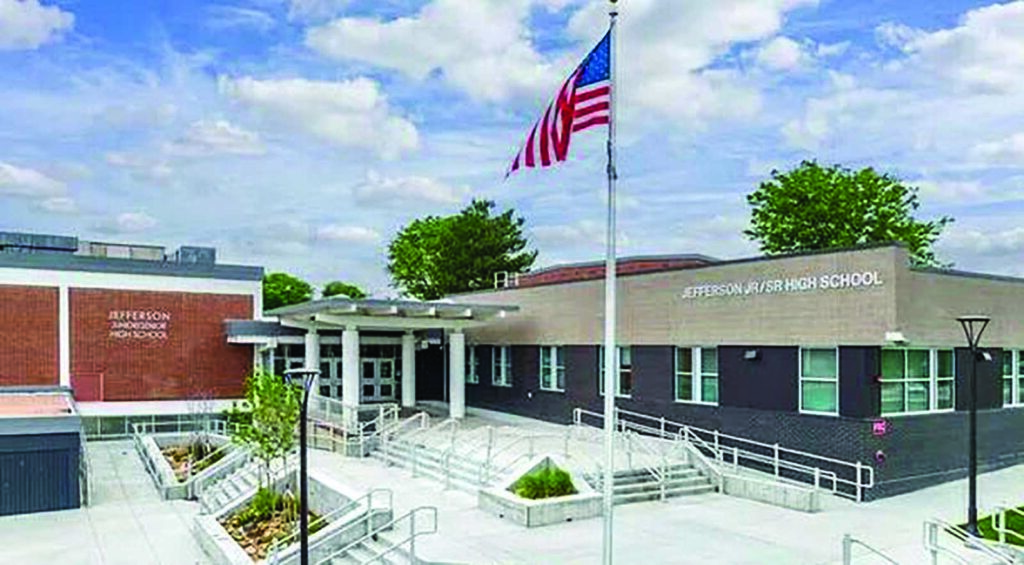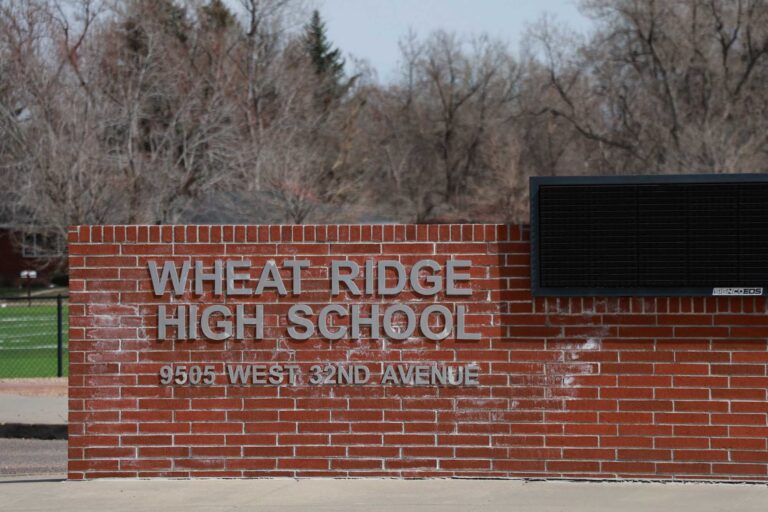Edgewater residents don’t want Jefferson Junior/Senior High School to close and have developed a plan to hopefully reverse its declining enrollment.
The Jefferson County School District has proposed to close Jefferson for the 2026-27 school year and merge the Jefferson and Wheat Ridge articulation areas.
Everitt Middle School and Wheat Ridge High School would become the boundary schools for Jefferson students, although families can exercise school choice, dependent on enrollment numbers.
According to a district web page, the district explored potential high school models nationwide and identified two viable options:
- A career technical education campus — a part-time program to explore career options like trades or technology similar to Warren Tech; and
- An academy model — a full-time program focused on teamwork, hands-on learning and help from businesses and the community.
In an interview, Joel Newton, executive director of the nonprofit Edgewater Collective, said the group believes the school district, which hasn’t closed any high schools in a long time, doesn’t understand how junior high and high school students will be affected.
“We want to see Jefferson kept open,” Newton said. “We think that’s the best place for students in this area.”
‘Creative solution’ achievable, group believes
Since the district announced its plans in January, the collective met with students, families, educators, alumni and community members. On its website, the group said a few themes grew out of the conversations.
“The main theme is that our community does not like the two options that have been presented by the district,” the group stated. “We believe that our community knows our students and families best, and therefore, we should be given the opportunity to submit our own plan.”
The group wants the district to take its two options off the table because they “would not provide a high school experience that all of our students could attend regardless of their career interests.”
They added closing Jefferson “would have devastating implications for students, families, educators and our community.”
“Instead of closing the school or creating a technical school or academy that loses the Jefferson identity and what makes this place special,” the group post continued, “let’s invest in what works at Jefferson and think creatively about how to redesign specific elements of the school. We believe there is a creative solution, with strategic investments, that can change the academic and enrollment trajectory at Jefferson.”
A key is to continue the bilingualism and biculturalism direction the school has taken, “continuing the family atmosphere of connectedness at Jefferson, maintaining the Jefferson identity and uniqueness, continuing successful sports and out-of-school programming, creating and sustaining innovative career pathways.”
“Enhancing the bilingual and bicultural programs at Jefferson … can strengthen the educational experiences for all Jefferson students and draw in new students from other dual language elementary schools in Jefferson County and Denver Public Schools,” the group’s plan states.
Important to that emphasis is keeping both Lumberg and Edgewater elementaries prekindergarten-6th grade schools, they added. When students then attend Jefferson for 7th grade, they take the next step in their language and cultural learning.
The group also noted junior high students need different educational experiences based on their ages compared to high school students. They recommend exploring how learning can be restructured for 7th- and 8th-grade students and develop “solid learning communities” separate from high school students.
“This would mean looking at how administration is configured as well as hiring and retaining educators that understand the needs and opportunities for 7th- and 8th-grade learners,” the group stated. “This would also mean re-looking at how the building is configured so junior high students can have separate learning spaces. It could also mean exploring a separate entrance for junior high students like was promised by the district in 2014-15.”
Career pathways could be expanded, the group’s post added. For example, the collective received a $100,000 grant from the Colorado Department of Transportation to help Jefferson students build an electric vehicle and learn about the emerging electric vehicle industry. This could help them land high-paying auto industry jobs, the group’s post stated.
Another step could be to expand Jefferson’s culinary arts pathway so students can learn about sustainable food systems, the food industry and business principles. Students might also learn about menu planning, food procurement and help prepare meals served at Jefferson and delivered to the elementary schools.
The group believes its plan would need at least five years to bear fruit. An agreement is proposed to keep the district and community on the same path over that period.
The group noted time is an important factor. Due to low test scores, Jefferson is in the third year of the Colorado Department of Education turnaround process.
If test scores, academic growth and test participation don’t improve over the next year, the state could step in and force the district to make changes. The group’s plan suggests models like a community or innovation school might allow Jefferson to exit the turnaround process.
Getting lost at WRHS, new SRO planned
Newton said the plan is not based on any other school models he’s seen nationwide.
“We just saw this as a chance for the community to have some input,” he added. “If the school district goes forward with its plan, there will be a number of Edgewater students who will get lost in their transition to Wheat Ridge High School. They won’t have a great educational experience and it can affect them psychologically.”
“And we’re not saying anything bad about Wheat Ridge schools,” Newton continued. “It just happens in cases like this. The Wheat Ridge community is part of this, too.”
Wheat Ridge Police Department spokesman Alex Rose said the department will likely add a part-time SRO, partly due to the planned Jefferson closure and the added students who enroll in Wheat Ridge schools. Two current full-time SROs rotate as needed between Wheat Ridge High, Everitt, the elementary schools and the Sobesky Academy, Rose added.
The new officer would be paid for by the city and the school district, he noted.
“We started discussing it with the school district before the closure was talked about so we’re kind of committed,” Rose said. “We had seen the demands on our two SROs were growing, so this is an opportunity to help.”
The new officer would also serve as a business liaison when schools are on summer vacation, Rose stated.
District cites low student numbers, money issues
The district web page noted that after decades of declining enrollment, Jefferson enrolls fewer students with around 600 in grades 7-12 compared to other similar district schools that serve 980 to 1,200 students.
“Even with extra funding, it has become increasingly difficult to provide a secondary education experience that provides a wide variety of core academic classes, electives and extracurricular activities that students need, deserve and desire,” the web page added. It also noted the Jefferson community “has expressed a clear desire for change.”
The school board is expected to consider a decision in June or August. If approved, Jefferson would close at the end of the 2025-26 school year.
Starting in the 2026-27 school year, Edgewater and Lumberg would serve preschool–5th graders, Everitt would teach students in grades 6-8, Wheat Ridge High School grades 9-12.
Jefferson would be remodeled and, “as soon as” the 2027-28 school year, reopen under whatever educational program the school board approves.
The district also noted Wheat Ridge High and Everitt have room for all Edgewater students. The high school has space for 1,700 students and 958 students this year. If Jefferson closes, the district expects this school’s enrollment to reach 1,072 to 1,242 students.
Everitt has enough space for 895 students (456 this year) and the district believes Everitt’s enrollment could grow to between 556 to 702 students after Jefferson closes.
Jefferson is currently spending the most per pupil than other district schools, the district noted, but has fewer electives, academic course offerings, athletics and activities. The district said that was due to a lack of enrolled students “… despite the extra funding.”
Newton said the Edgewater group — with about 30 active members — would present their plan to the district at a March 31 community design session.
“Families and staff are already looking at other schools for the 2025-26 school year,” the group’s post noted. “Our community needs to be involved in this option so families and educators have a great reason for remaining in the community they love.”






